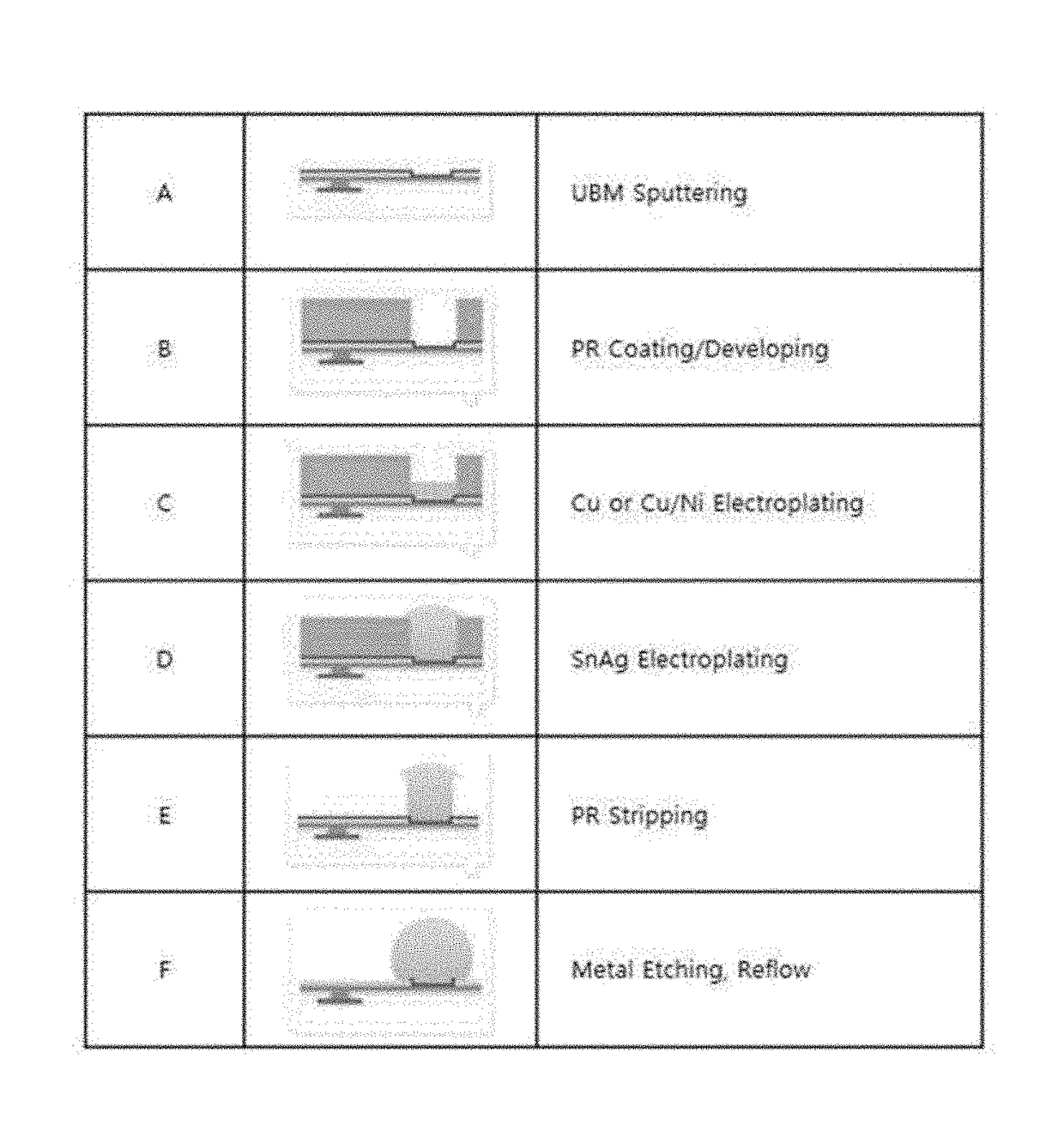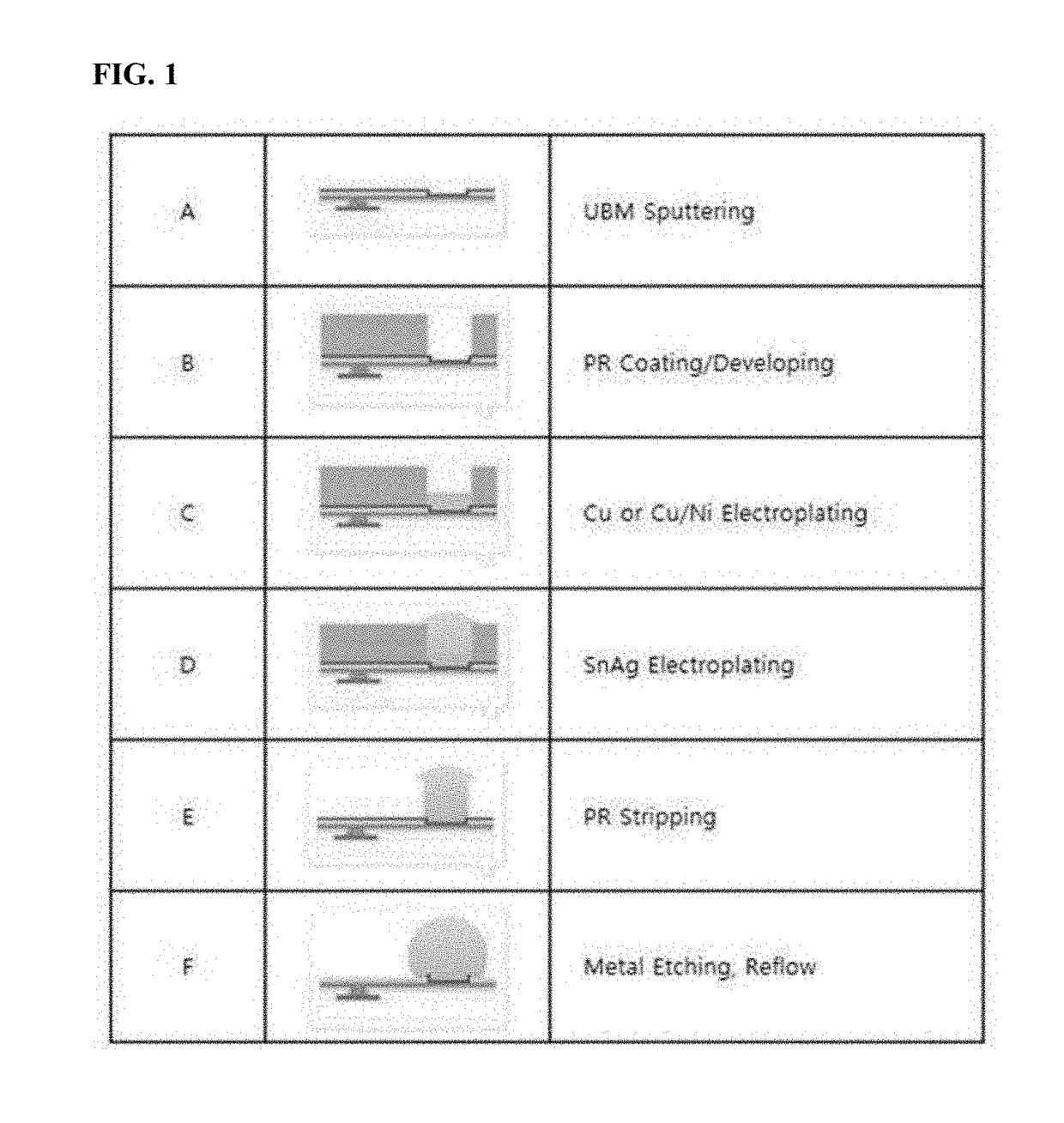Tin alloy electroplating solution for solder bumps including perfluoroalkyl surfactant
a technology of perfluoroalkyl surfactant and tin alloy, which is applied in the direction of semiconductor devices, semiconductor/solid-state device details, electrical apparatus, etc., can solve the problems of reducing the size of the system or improving the electrical performance, defectiveness, yield and quality of products, and formation of empty spaces inside bumps, so as to improve the surface tension, wettability and spreadability of tin-based electroplating solution, and improve the current efficiency of the plating
- Summary
- Abstract
- Description
- Claims
- Application Information
AI Technical Summary
Benefits of technology
Problems solved by technology
Method used
Image
Examples
example 1
on of Tin-Silver Plating Solution
[0062]Tin methanesulfonate (based on the final tin content (95 g / L)), silver methanesulfonate (based on the final silver content (2.0 g / L)), 100 g / L of methanesulfonic acid, 0.1 mg / L of potassium perfluorinated octyl sulfonate, 13.5 g / L of polyoxyethylenestyrenic phenyl ether, 1.5 g / L of polyoxyethylene bisphenol F ether, and 270 g / L of thiodiglycol as a complexing agent were mixed with stirring and filtered through a cartridge filter having a pore size of several micrometers to prepare a tin-silver alloy plating solution.
example 2
istics of Tin-Based Solder Bumps
[0064]In this example, the shapes and characteristics of tin-silver alloy bumps were observed. The tin-silver electroplating solution of Example 1 was electroplated on the copper pillars, which were formed on the 12-inch patterned wafer in Preparative Example 1, to form solder bumps. The tin-silver electroplating was performed at a current density of 13 A / dm2 while stirring the plating solution at room temperature. The plating speed was 6.6 μm / min at 13 A / dm2. A current efficiency of 99.5% and a silver content of 2.2% were attained. After heating to 240° C. at a rate of 2° C. / min and cooling at a rate of 3° C. / min, solder reflow was performed. The solder bumps were well patterned (bump CD 20-60 μm, bump pitch 95-190 μm) and the plating tendency was good regardless of the shape (pillar or mushroom shape) of the solder bumps. Meanwhile, tin-silver plating was performed at different current densities. The current efficiencies of the plating were found to...
example 3
of the Fluorinated Surfactant
[0066]In this example, the shape and characteristics of tin-silver alloy bumps were observed. Similarly to Evaluation Example 1, the tin-silver electroplating solution of Example 1 was electroplated on the 12-inch patterned wafer formed with the under bump metallurgy layer, which was prepared in Preparative Example 1, to form solder bumps. Example 3 was different from Evaluation Example 1 in that the plated patterned wafer used in Preparative Example 1 was cut into a test piece having a size of 3×3 cm2, which was used as a cathode, a platinum-coated titanium electrode was used as an anode, and galvanostatic plating was performed at current densities of 5 and 10 A / dm2 while stirring 250 mL of the electroplating solution at a rate of 250 rpm until the thickness reached 20 μm. The characteristics of the solder bumps were measured and the results are shown in Table 2 and FIGS. 5 (5a) and 6 (6a).
PUM
| Property | Measurement | Unit |
|---|---|---|
| concentration | aaaaa | aaaaa |
| concentration | aaaaa | aaaaa |
| particle size | aaaaa | aaaaa |
Abstract
Description
Claims
Application Information
 Login to View More
Login to View More - R&D
- Intellectual Property
- Life Sciences
- Materials
- Tech Scout
- Unparalleled Data Quality
- Higher Quality Content
- 60% Fewer Hallucinations
Browse by: Latest US Patents, China's latest patents, Technical Efficacy Thesaurus, Application Domain, Technology Topic, Popular Technical Reports.
© 2025 PatSnap. All rights reserved.Legal|Privacy policy|Modern Slavery Act Transparency Statement|Sitemap|About US| Contact US: help@patsnap.com



